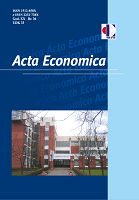THE INNOVATION PARADOX IN THE SERBIAN ECONOMY: THE GRANGER CAUSALITY APPROACH
THE INNOVATION PARADOX IN THE SERBIAN ECONOMY: THE GRANGER CAUSALITY APPROACH
Author(s): Lidija MadžarSubject(s): National Economy, Economic history, Economic development, Transformation Period (1990 - 2010), Present Times (2010 - today)
Published by: Економски факултет Универзитета у Бањој Луци
Keywords: Serbia; innovations; patent applications; gross domestic product (GDP); gross expenditures for research and development (GERD); vector autoregressive (VAR) model; Granger causality test;
Summary/Abstract: Innovations, as the applications of new ideas, solutions and technological practices that improve goods, services and business processes, are the most important driver of economic progress. They lead to greater productivity and efficiency, and therefore to better economic results. The purpose of this article is to examine the state, interrelation and the impact of innovative activities on the economic growth of Serbia. The paper first uses standard multiple regression and concludes that in the period from 2004 to 2020, the number of registered patents did not contribute, while the gross expenditures for research and development (GERD) contributed positively and significantly to the growth of the Serbian GDP. Therefore, it can be said that Serbia is facing a kind of innovation paradox, since the growth of allocations coexists with a dramatic decrease in the number of registered patents. Its second part is based on the construction of the corresponding Vector autoregressive VAR(1) model that traces the causal relationship between GERD and the economic growth of Serbia in the period from 1997 to 2020. It follows that while GERD does not cause GDP in the Granger sense, the GDP causes GERD allocations for innovative activities in Serbia. The scientific research work in Serbia is not efficient and effective enough because it draws funds from the GDP, but does not meet expectations and does not produce tangible results, especially in the expected number of registered patents. Therefore, it is necessary to build an appropriate incentive environment that would stimulate more adequately and value new innovative ventures.
Journal: Acta Economica
- Issue Year: 20/2022
- Issue No: 37
- Page Range: 9-27
- Page Count: 19
- Language: English

